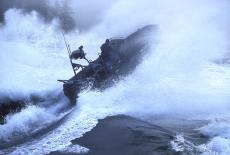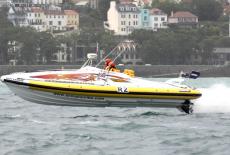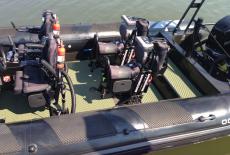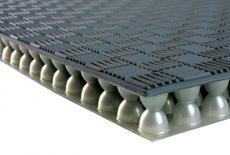Riders On The Storm - Decks & Seats On Fast Boats

15.11.2015
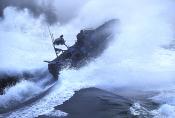
Riders On The Storm Professionals and Waves
The definition of shock mitigation is, ‘to make a violent collision or impact less intense.’ A shock mitigation strategy is essential for all craft that undertake open sea transits or operate in rough water.
The search for shock mitigation has created a range of solutions. But what and where are the forces that really affect people when standing and sitting onboard fast boats in waves.
In the 1980s criminal organisations capable of buying fast boats were most likely running something, or someone, illegal in from offshore. As boats were purchased and money changed hands the simple questions ‘what payload’ and ‘how fast’ were being asked from the Mediterranean to the Caribbean.
These organisations soon owned the fastest boats on the water. Seating was irrelevant and crews were usually standing on hard decks as any wasted space or weight reduced the all important payload. As the distance from Morocco to Spain and Bimini to Miami is around 50 miles, identifying a boat capable of over 50 knots was an important criteria.
In the early days of counter ‘go fast’ operations for marine police, customs and borders organisations the focus was firmly placed on procuring high performance hulls to chase down offenders. Boat crews and enforcement officers were usually standing in wrap around bolsters or leaning against padded rails. There were no seats and these hard core operators were using their experience, balance and leg muscles to ride the boat.
Go Fast Operations & Shock Mitigation
Countering a high value, high speed run in from the Bahamas or the Caribbean required a capable fast response boat with fit crews ready for a short sharp pursuit, usually at night, that often ended in a ‘lights off’ high speed chase in the inter coastal waterways. This was a brief one on one, win or lose, situation with lucrative pay off for a single evasion. The speeds achieved by ‘cigarette boats’ on weekend offshore powerboat races and poker runs in Southern Florida suddenly became significant!
The history of ‘shock mitigation’ technology can be traced back to the 1990’s and the rapidly changing requirements of counter narcotics and military marine operations as boats became faster with extended and more complex missions. However the game changer for homeland security in port and maritime security operations was 9/11. As the global stakes changed and requirements were analysed it became obvious that security and military boats would need to operate faster than ever before. The people on them would need to be ‘fit to fight’ determined adversaries after a fast transit in extreme sea conditions...
Fast Craft Operations & Over Engineering
As high speed craft designers and professional sector boat builders rose to the challenge they built in ‘over engineering’ wherever possible. In the early days of shock mitigation ‘feet off the deck’ suspension seating incorporated complex engineered solutions, often adapted from land vehicles. Other manufacturers then started to offer lighter and simpler ‘feet on the deck’ jockey suspension seats.
Next generation manufacturers have created a range of suspension seats and adjustable shock mitigation systems to enable humans to operate fast craft in the roughest of conditions. These solutions utilise sophisticated mechanical engineering to disconnect the boat occupant from G forces as the hull moves over rough water and wave conditions. Taking this a stage further, the latest shock mitigation technologies now utilise Man Machine Interface (MMI) to link coxswains, navigators, engineers, FLIR operators, gunners and commanders to their tasks, controls and screens.
With all this high technology there is an opportunity to step back and define what and where are the forces that we are really trying to reduce on the water. As ever at sea - simple is good!!
Shock Mitigation By All Means
Shock mitigation is important for people who want to go further, faster or for longer in extreme conditions. RHIBs are an outstanding way to get afloat but as technology changes even a very fit human body has its limits. One of the things that marine professionals have in common is a growing awareness of injury. As crews need to focus on the task at hand it is important to protect all occupants of fast boats from injury, whether they are sitting or standing.
When a RHIB is running in flat conditions occupants experience vibration coming up through their feet on the deck, held there by gravity and body mass. There is no doubt that light agile people have an advantage, but try telling that to a big military operator in heavy body armour.
In flat sea conditions there is vibration from the engine, but boat occupants are not exposed to harm. All fast boat operators know that waves change everything! Waves can be wind blown and build up in a few minutes or can be caused by the wake from larger vessels even in calm weather conditions.
As powerboats get lighter and faster there are new issues to consider. Operating a fast boat in flat water conditions is relatively easy. But operators running powerboats at high speed need to understand the forces they are dealing with. What is vibration and impact doing to novice crews and less experienced passengers when the boat hits a wave?
Professional high speed craft operators need a combination of shock mitigation solutions. But there is no ‘silver bullet’, shock mitigation is about reducing forces and potential injury by a few percent wherever possible via the hull, seats and deck.
Whole Body Vibration & Repetitive Shock
Whole Body Vibration (WBV) exposure on planing craft is usually caused by continuous 'hammering' from short steep seas or wind against tide conditions. Repetitive Shock (RS) on planing craft is usually caused by random 'hits' from head sea impacts, crossing seas or overtaking following seas.
At commercial boat shows around the world it would appear that the fast craft sector has adopted suspension seats as the only shock mitigation solution. In reality the new hi tech craft at shows only represent a tip of the iceberg. The majority of in-service craft belong to hard working organisations with budget constraints and limited space on deck, or are close to their payload for lifting by dockside crane or onboard davit.
The EC Vibration Directive came into force in 2010 and there is now an increasing awareness that professional operators need to reduce the effects of vibration on their employees by all means. Fast boat drivers know that even moderate sea conditions can be painful and may lead to serious injuries to ankles, knees, lower back and neck. What they often do not realise is that a fast boat in 1 metre (3 feet) seas can measure impacts of up to 10g on the deck.
Sitting & Standing On Fast Boats
Research in the past decade has led to a better understanding of the forces involved on the human body at sea. Professional organisations are now asking what they can do to reduce the effects of vibration and potential injury as the effects of fast boat transits take their toll on the fitness and long-term health of personnel.
On jockey or straddle style suspension seats the occupants feet are still on the deck. In a head sea or following sea transit, some of the forces are vertical (usually referred to as Z axis) and some of the forces are fore and aft (usually referred to as X axis). The boat rarely moves sideways (usually referred to as Y axis) but side-on seas cause random events plus a combination of forces that cannot be predicted and create the most damaging vector of forces on the human body.
On certain craft there is the option to retrofit suspension seating. But if seats are too large to fit, or are simply too costly, then operators will need to find other methods to reduce the effects of vibration and impact on the human body. With boats now expected to last 15 to 20 years many military, police, government and commercial organisations will not retrofit suspension seats and crews will simply have to continue to stand in anything other than calm conditions. Military and professional operators around the world are now looking at the deck and considering how to reduce the forces there.
High G Forces for Occupants
The big force that all crews are aware of in a RHIB is when the boat climbs over the top of a wave and occupants experience a negative gravity sensation, just like the hump on a roller coaster. As the boat lands the Vee of the hull displaces water then, due to buoyancy, it can go no deeper. A few milliseconds later occupants land on the deck and their body decelerates with everything from the head down pushing into the feet if standing, or into the backside if sitting. Visit any physical therapist and they will show you the weak points of the human skeleton. Ask a group of fast craft professionals where it hurts and you will usually get the same answer - lower back, knees and hips.
On boats without suspension seats experienced operators usually chose to drive RHIBs standing up in anything but flat conditions. As the seas get bigger most fast boat operators prefer to stand to see oncoming waves and use their legs to balance and absorb the boats movement. At that point they also have the opportunity to engage and use an incredibly complex suspension system - the human body.
To enhance the standing position crews need to consider what they are standing on. Typical decks made of aluminium, fibreglass and composite materials transmit shocks and vibration. Standing on foam or rubber flooring is an option, but most of these materials lack stability which causes fatigue. This is where the constant ‘firing’ of ankle and calf muscles eventually leads to shaking legs. When simply standing on most foam products the material is already pre-loaded, which means the feet sink towards the deck, therefore reducing the depth of cushioning. For heavier occupants in wave conditions it becomes increasingly likely to bottom out which feels like the underside of the feet have been hit with a hammer.
Impact Mitigating Boat Decking
The shock transfer to crews and passengers standing on non-cushioned deck surfaces is significant when operating at speed, even in moderate sea states. Just as suspension seats are more engineered than standard foam seats, impact mitigating boat decking solutions need to be more engineered than simple rubber or foam. Skydex Technologies have developed high-performance boat decking products that use patented energy-absorbing geometries to reduce the effects of impacts and dampen vibration on RHIBs and high speed craft. The objective is to reduce the potential for injury to personnel, and protect equipment carried on deck, when exposed to wave slam events in fast craft operations.
James Taylor, President & CEO of Skydex Technologies, said, ‘Skydex has developed products that excel in harsh environments and our technology has been employed extensively around the world. The technology that we bring to the marine market is the same that we have supplied as blast mitigation flooring to protect the occupants in over 20,000 military vehicles.’
Skydex Boat Deck is available in a range of products, from 14mm to 50mm thickness, based on the level of deck coverage and mitigation required. This can be fitted on new boats or as a retro-fit solution to reduce the effects of shock and vibration for any craft. The technology works by utilizing elastomers and proprietary geometries to create a multiphase spring that is engineered to react differently to various levels of impact.
Peter Foley, Chief Technology Officer of Skydex Technologies, said, ‘Skydex works differently than foam and is tuned to react to the expected levels of shock. For example in a wave impact situation, particularly in the dark, the human body cannot react fast enough to protect itself from the shock. Skydex reacts instantly to the forces, plus the technology works in all axes to reduce the effect on the human body whether the boat is landing vertically, into head seas or even side on.’
Impact mitigating decking can be particularly beneficial on boats with leaning posts and on boats with fixed jockey or straddle seats where the occupants stand in rough conditions. Even ‘feet on the deck’ suspension seats require the occupant to use their leg muscles and carry a percentage of body weight on the deck, this can result in a significant weight on one leg particularly in crossing or side on seas.
A holistic approach to shock mitigation solutions on the water can improve comfort and reduce the effects of shock and vibration on the human body for crew and passengers. This can minimise downtime from injuries and extend the working life of maritime professionals.
By John Haynes
The author is an Associate Fellow of the Nautical Institute, a Yachtmaster Ocean and Advanced Powerboat Instructor. Subject matter expertise includes high speed craft consultancy, product development and specialist RS & WBV Awareness training.
Images
- High performance Zodiac Hurricane RHIB with shock mitigation
- Round Britain record holder ‘Hot Lemon’ with crew standing
- Skydex Boat Decking on RHIB with shock mitigation seating
- Skydex Impact Mitigating Boat Decking
Riders On The Storm - Decks & Seats On Fast Boats - by John Haynes
All images are copyright RIB & HSC 2024 unless otherwise stated.
This does not exclude the owner's assertion of copyright over the material.

09.07.2024
NEXT GEN Marine BATTERY Workshop via Teams
NEXT GEN Marine BATTERY Workshop is being held via…
05.01.2024
The Challenges of Unpredictable Marine Energy
From military to superyacht, it is clear there is an urgent…
Southampton International Boat Show 2024
Dates:
13 to 22 September 2024
Location:
Southampton UK
Foiling and Flying RIBs
Foiling powerboat designed to meet military needs - fast, stable, silent, fuel-saving. Collaboration by SEAir Foiling Systems and Sillinger RIBs.…














